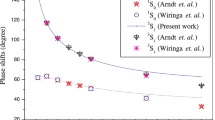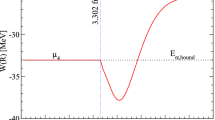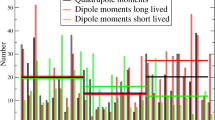Summary
We develop an approximate size consistent method within a framework of the multi-reference configuration interaction scheme. The Rayleigh-Schrödinger perturbation theory is employed with a specific selection of the unperturbed part of the electronic Hamiltonian. The second order energy is obtained by a set of equations similar to the quasidegenerate variational perturbation theory of Cave and Davidson. The approximate fourth order energy is obtained by solving a set of equations similar to the coupled electron pair approximation (CEPA). The method has been tested for two simple systems, BeH2 and N2, and the results are quite encouraging.
Similar content being viewed by others
References
Shavitt I (1977) The method of configuration interaction. In: Schaefer III HF (ed) Methods of electronic structure theory, vol. 3. Plenum Press, New York, pp 189–276
Roos BO and Siegbahn PEM (1977) The direct configuration interaction method from molecular integrals. In: Schaefer III HF (ed) Methods of electronic structure theory, vol. 3. Plenum Press, New York, pp 277–318
Davidson ER (1974) Intern J Quantum Chem VII:83–89
Shavitt I (1977) Intern J Quantum Chem Symp 11:131–148, (1978) ibid 12:5–32
Siegbahn PEM (1980) J Chem Phys 72:1647–1656
Liu B, Yoshimine M (1981) J Chem Phys 74:612–616
Taylor PR (1981) J Chem Phys 74:1256–1270
Buenker RJ, Peyerimhoff SD (1974) Theor Chim Acta 35:33–58; (1975) ibid 39:217–228
Knowles PJ, Handy NC (1984) Chem Phys Letters 111:315–321
Sasaki F, Tanaka K, Noro T, Togasi M, Nomura T, Sekiya M, Gonoi T, Ohno K (1987) Theor Chim Acta 72:123–138
Nesbet RK (1965) Advan Chem Phys 9:321–363; (1969) ibid 14:1–34
Bartlett RJ (1981) Annu Rev Phys Chem 32:359–401
Langhoff SR, Davidson ER (1974) Int J Quantum Chem VIII:61–72
Davidson ER, Silver DW (1977) Chem Phys Letters 52:403–406
Buenker RJ, Shih S-K, Peyerimhoff SD (1979) Chem Phys 36:97–112
Burton PG, Gray PD (1983) Chem Phys Letters 96:453–457
Meissner L (1988) Chem Phys Letters 146:204–210
Davidson ER, McMurchie LE, Day SJ (1981) J Chem Phys 74:5491–5496
Cave RJ, Davidson ER (1988) J Chem Phys 88:5770–5778
Cave RJ, Davidson ER (1988) J Chem Phys 89:6798–6814
Ahlrichs R, Scharf P, Ehrhardt C (1985) J Chem Phys 82:890–898
Gdanitz RJ, Ahlrichs R (1988) Chem Phys Letters 143:413–420
Kutzelnigg W (1977) Pair correlation theories. In: Schaefer III HF (ed) Methods of electronic structure theory, vol.3. Plenum Press, NewYork, pp129–188
Meyer W (1977) Configuration expansion by means of pseudonatural orbitals. In: Schaefer III HF (ed) Methods of electronic structure theory, vol. 3. Plenum Press, New York, pp 413–446
Cizek J (1966) J Chem Phys 45:4256–4266; Cizek J (1969) Adv Chem Phys 14:35–91
Pople JA, Krishnan R, Schlegel HB, Binkley JS (1978) Int J Quantum Chem XIV:545–560
Jeziorski B, Monkhorst HJ (1981) Phys Rev A24:1668–1681
Lindgren I (1978) Int J Quantum Chem S12:33–58
Mukherjee D (1986) Chem Phys Letters 125:207–212
Nakatsuji H (1985) J Chem Phys 83:713–722
Meissner L, Jankowski K, Wasilewski J (1988) Int J Quantum Chem XXXIV:535–557
Shavitt I, Redmon LT (1980) J Chem Phys 73:5711–5717
Banerjee A, Simons J (1981) Int J Quantum Chem 19:207–216; (1982) J Chem Phys 76:4548–4559
Baker H, Robb MA (1983) Mol Phys 50:1077–1082
Tanaka K, Terashima H (1984) Chem Phys Letters 106:558–562
Laidig WD, Bartlett RJ (1984) Chem Phys Letters 104:424–430; Laidig WD, Saxe P, Bartlett RJ (1987) J Chem Phys 86:887–907
Kutzelnigg W. (1975) Chem Phys Letters 35:283–285
Purvis III GD, Bartlett RJ (1982) J Chem Phys 76:1910–1918
Purvis III GD, Shepard R, Brown FB, Bartlett RJ (1983) Int J Quantum Chem XXIII:835–846
Dunning TH (1970) J Chem Phys 53:2823–2833
Huzinaga S (1965) J Chem Phys 42:1293–1302
McLean AD, Liu B (1973) J Chem Phys 58:1066–1078
Bauschlicher Jr CW, Langhoff SR (1987) J Chem Phys 86:5595–5599
Werner H-J, Knoles PJ (1988) J Chem Phys 89:5803–5814
Kashiwagi H, Takada T, Miyoshi E, Obara S, Sasaki F (1977) Library program of the computer center of Institute for Molecular Science, Okazaki, Japan
Murakami A, Iwaki H, Terashima H, Shoda T, Kawaguchi T, Noro T (1985) Library program of the computing center of Hokkaido University, Sapporo, Japan
Author information
Authors and Affiliations
Rights and permissions
About this article
Cite this article
Tanaka, K., Sakai, T. & Terashima, H. A method of incorporating quadruple correction in the scheme of multi-reference singly and doubly excited configuration interaction — a CSF based coupled pair approximation. Theoret. Chim. Acta 76, 213–225 (1989). https://doi.org/10.1007/BF00532005
Received:
Revised:
Accepted:
Issue Date:
DOI: https://doi.org/10.1007/BF00532005




